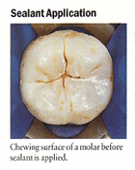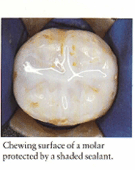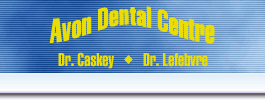
Seal Out Tooth Decay!
Daily brushing, flossing, and fluorides form an effective team in the fight
against
dental disease. Now,dentists are also using sealants to further
protect your child's
teeth from decay and to prevent him or her from ever
experiencing the discomfort
of a toothache.
What Are Sealants?
A sealant is a tough, plastic material designed to bond with tooth enamel.
Clear or
tooth-colored sealants are routinely applied to the chewing surfaces of the back
teeth.
This invisible barrier reduces the risk of tooth decay by keeping food and
plaque out of cavity prone areas. The procedure is pain free and non-invasive.
What Are Pits And Fissures?
During normal tooth development, deep grooves form in the back teeth.
These
grooves are called fissures. A pit forms where two fissures cross.
These pits and
fissures fill up with food and bacteria.
Because toothbrush bristles are too thick
to reach into the pitsand fissures,
the food and bacteria cannot be easily removed
by brushing, flossing, or
rinsing. The protective enamel layer on the tooth is
particularly thin in
these pits and fissures.
Bacteria acts on the food to form strong
acids that weaken and destroy the
tooth enamel. Decay starts, and a cavity is
formed. In order to save the
tooth, it must be repaired by a dentist.
Why Use Sealants?
The use of fluorides have dramatically reduced the incidence of tooth decay.
However, fluorides are most effective in protecting the smooth surfaces
of the
teeth. Their use is limited in the pit and
fissures area. Sealants provide additional
protection by shielding these
hard to reach grooves from decay-causing agents.
When Should Sealants Be Applied?
Tooth decay occurs much faster in children than in adults. Sealants should
be
applied to a child teeth as soon as possible, before decay has had a chance
to set in.
How Are Sealants Applied?
Sealants are applied quickly and easily by either the dentist or dental hygienist.
There is no discomfort and no need for anesthesia. First, the teeth are thoroughly
cleaned to remove debris and bacteria.
Then, the surfaces to be sealed are
chemically treated to etch the tooth
for better bonding. The liquid sealant is then
painted on the surface of
the
tooth, where it flows into the pits and fissures.
Some
sealants harden with air exposure; others require ultraviolet or visible
light. A hand
held "light wand" may be used for this purpose.



How Long Do Sealants Last?
Sealants usually last many years. The abrasive nature of some foods, like
ice,
hard candy, or sticky foods can dislodge or damage a sealant. When
this happens,
the sealant can be
reapplied to the tooth.
Decay and Sealants
If the decay process has already started, it is too late to apply sealants
as a
preventative measure. Decay will not start under a fissure sealant
because the
decay causing organisms are deprived of the food
and oxygen they need to flourish.
Summary
The use of sealants substantially reduces the risk of tooth decay by keeping
food
and bacteria out of cavity prone areas. In combination with careful
brushing, flossing,
and fluorides, sealants are an effective step towards
a lifetime of excellent dental health.
Return to Top

Avon Dental Centre © All Rights Reserved 2003 Web Design By SBL Prod. |








